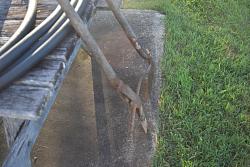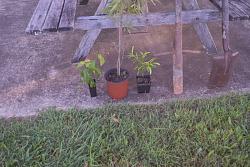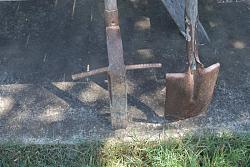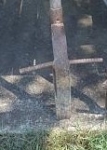This digger is like a cross between a crowbar & a post hole shovel. It is much easier to use than a crow bar, mattock or pick as it is relatively thin & easier than a post hole shovel as it is only 3" wide so less energy needed/spent in many ground types.
the prototype 1 had a flat blade made from very old flat steel that my grandfather gave me in the 60's to assist in bending thin plate but as the edges were rounded I simply stored for a rainy day. It was very good at digging holes for micro tubes, mini tube stock, and maxi tubes.
It was also excellent at squaring holes in compacted soil where it is necessary to not plant in augered holes as the plants become "potbound" in the ground and eventually die even after vigerous growth. The squaring of the augered hole of course is not necessary in sand & friable soils but is imperative in extremely hard ground. What the square vertical cut does is it encourages the roots to seek out an escape into contiguous ground and breaking away from the easy circular run until no more space & nitrients are left in the hole.
About 15 to 20 years ago I saw an article from the top local "Landcare" guy where he had cut a post hole shovel to about 3" wide but leaving the top tread area for strength. I decided to use a leaf spring using the rounded end. The blade would have curved the wrong way & my 20 ton press could not bend it successfully. A friend had a press, oxy etc & did that little job fot me.
The curved blade is so much better as there is much more leverage. I have had two quality hardwood handles on this current one (used daily originally & left in all weathers in my ute/pickup) but it would last a lifetime if sanded and linseed oil applied fairly regularly.
For regeneration work this tool excells. For less weeds the planter needs a minimal disturbance to the soil to avoid "opening up the seed bank" therein the soil. To further reduce disturbance to the soil the tool is used the same way for both cuts & a curved V is avoided in the soil which levers the soil in 2 directions. With this method the broken soil is hand retrieved & some fertilizer dropped in & a skim of soil placed thereon. T hole is then watered. after seepage the seedling/sapling is planted and the remaining soil used to complete the job. Some studies have shown that many species esp regen ones can be planted below normal level (and any leaves/branches under new level removed) & the extra stem underground rewards the planter with extra roots and better more vigerous stronger growth.
I used to use Blood & bone sprinkled around the seedling. This works to deter Hares/rabbits but unfortunately encourages Bandicoots and grass /weed growth so I have discontinued this practice. Any local leaf matter / old mulch will help balance temperature & keep moisture in to boot.
After planting a good soaking can be advantageous but avoid a little here & a little there as the plant wont adapt to its environment. You can give a thorough soak when the plant is in stress.


 LinkBack URL
LinkBack URL About LinkBacks
About LinkBacks





 Reply With Quote
Reply With Quote





Bookmarks